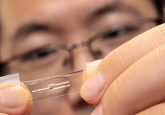On the origins of life

A simple chemical process, involving α-hydroxy acids, may have been important to the origin of life on earth.

A wet–dry scenario in a prebiotic hot spring or tidal pool. A) shows the pool with the five kinds of α-hydroxy acids used in this study. B) shows the drying pool where a “library” of polyesters, depicted as the inset high-resolution mass spectra, forms at the drying edges. This simple formation of polyesters could have played a role in scaffolding the origins of life. Credit: Kuhan Chandru.
Scientists at the Tokyo Institute of Technology (Tokyo, Japan) have successfully shown that reactions to generate polymers from α-hydroxy acids can be achieved under the prevailing conditions at the time of the earth’s origin. The research, published in Communications Chemistry, sheds light on the murky origins of life on earth and gives a plausible mechanism for its beginning.
The setting of the spark of life that led to the generation of the diversity seen on our planet today is often debated. Some theories suggest that likely environments for life to have arisen are from tidal pools or hot springs. These environments could provide suitable conditions for the chemical reactions required to generate the molecules necessary for life.
However, it is the linking of molecules, or polymerization, that is a fundamental step in generating more complex molecules to precursor life. The polymerization of amino acids generates strands of DNA. The team managed to show that hydroxyl acids polymerize much easier than amino acids and without the help of enzymes, which is a crucial ability in primordial conditions.
To test the extremities of the conditions this polymerization could occur under, the team generated a series of experimental conditions. They set up environments of varying pH and temperature levels and utilized high-resolution mass spectrometry to reveal the environmental range in which these molecules can form.
The team also found that they could generate a large variety of polymers by using different amounts and types of α-hydroxy acid. They created a library of molecules from five different α-hydroxy acids, which could generate millions of distinct polymer sequences.
This research gives a fundamental base for the generation of life. The team are looking forward to continuing their research to generate more molecules, and maybe even reveal the secrets of self-replication.
